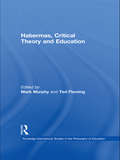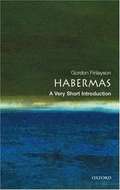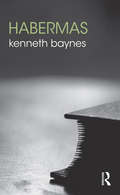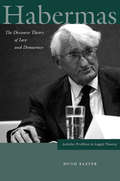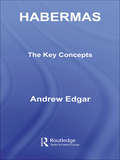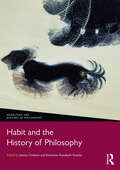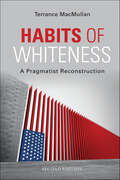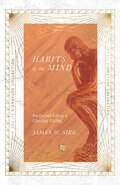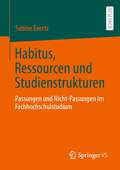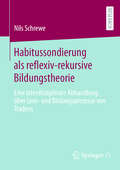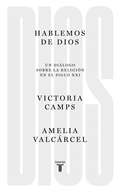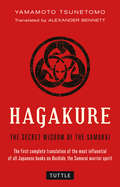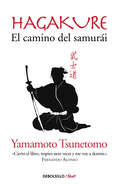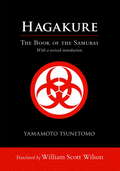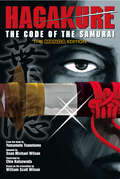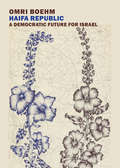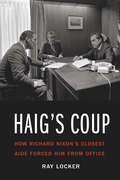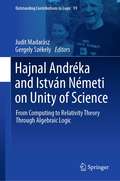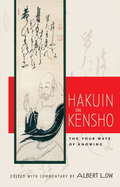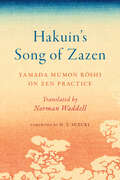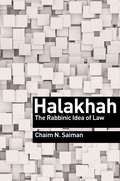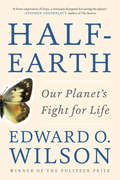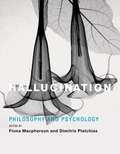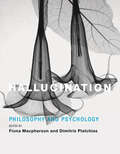- Table View
- List View
Habermas, Critical Theory and Education (Routledge International Studies in the Philosophy of Education)
by Mark Murphy Ted FlemingThe sociologist and philosopher Jürgen Habermas has had a wide-ranging and significant impact on understandings of social change and social conflict. However, there has been no concerted and focused attempt to introduce his ideas to the field of education broadly. This book rectifies this omission and delivers a definitive contribution to the understanding of Habermas's oeuvre as it applies to the field. The authors examine the contribution Habermas's theory has and can make to: pedagogy, learning and classroom interaction; the relation between education, civil society and the state; forms of democracy, reason and critical thinking; and performativity, audit cultures and accountability. Additionally, the book answers a range of more specific questions, including: what are the implications for pedagogy of a shift from a philosophy of consciousness to a philosophy of language?; What contribution can Habermas's re-shaping of speech act theory and communicative rationality make to theories of classroom interaction?; and how can his theories of reason and colonization be used to explore questions of governance and accountability in education?
Habermas: A Very Short Introduction
by James Gordon FinlaysonThis book gives a clear and readable overview of the philosophical work of Jurgen Habermas, the most influential German philosopher alive today, who has commented widely on subjects such as Marxism, the importance and effectiveness of communication, the reunification of Germany, and the European Union. Gordon Finlayson provides readers with a clear and readable overview of Habermas's forbiddingly complex philosophy using concrete examples and accessible language. He then goes on to analyze both the theoretical underpinnings of Habermas's social theory, and its more concrete applications in the fields of ethics, politics, and law; and concludes with an examination how Habermas's social and political theory informs his writing on contemporary, political, and social problems.
Habermas: Essays On Habermas's Between Facts And Norms (The Routledge Philosophers)
by Kenneth BaynesJürgen Habermas is one of the most important German philosophers and social theorists of the late twentieth and early twenty-first century. His work has been compared in scope with Max Weber’s, and in philosophical breadth to that of Kant and Hegel. In this much-needed introduction Kenneth Baynes engages with the full range of Habermas’s philosophical work, addressing his early arguments concerning the emergence of the public sphere and his initial attempt to reconstruct a critical theory of society in Knowledge and Human Interests. He then examines one of Habermas’s most influential works, The Theory of Communicative Action, including his controversial account of the rational interpretation of social action. Also covered is Habermas’s work on discourse ethics, political and legal theory, including his views on the relation between democracy and constitutionalism, and his arguments concerning human rights and cosmopolitanism. The final chapter assesses Habermas’s role as a polemical and prominent public intellectual and his criticism of postmodernism in The Philosophical Discourse of Modernity, in addition to his more recent writings on the relationship between religion and democracy. Habermas is an invaluable guide to this key figure in contemporary philosophy, and suitable for anyone coming to his work for the first time.
Habermas: The Discourse Theory of Law and Democracy
by Hugh BaxterThough many legal theorists are familiar with Jürgen Habermas's work addressing core legal concerns, they are not necessarily familiar with his earlier writings in philosophy and social theory. Because Habermas's later work on law invokes, without significant explanation, the whole battery of concepts developed in earlier phases of his career, even otherwise sympathetically inclined legal theorists face significant obstacles in evaluating his insights. A similar difficulty faces those outside the legal academy who are familiar with Habermas's earlier work. While they readily comprehend Habermas's basic social-theoretical concepts, without special legal training they have difficulty reliably assessing his recent engagement with contemporary legal thought. This new work bridges the gap between legal experts and those without special legal training, critically assessing the attempt of an unquestionably preeminent philosopher and social theorist to engage the world of law.
Habermas: The Key Concepts (Routledge Key Guides)
by Andrew EdgarAn independently minded champion of ‘the project of modernity’ in a supposedly post-modern age, Jurgen Habermas (1929- ) is one of the most widely influential thinkers of our times. An easy-to-use A-Z guide to a body of work that spans philosophy, sociology, politics, law and cultural theory, Habermas: The Key Concepts explores Habermas’ writings on: capitalism genetics law neo-conservatism universal pragmatics. Fully cross-referenced with extensive suggestions for further reading, this is an essential reference guide to one of the most important social theorists of the last century.
Habit and the History of Philosophy (Rewriting the History of Philosophy)
by Komarine Romdenh-Romluc Jeremy DunhamFor Aristotle, habit was a fundamental aspect of human nature; and for William James, it was the "enormous flywheel" of society. In both the history of philosophy and contemporary research, it is acknowledged as a fundamental topic in ethics, moral psychology, philosophy of action, and phenomenology. This major volume, written by a team of international contributors, is an outstanding collection that offers a thorough and diverse philosophical exploration of habit from the classical period to the modern day. Carefully edited to reflect the breadth of the subject, its 18 chapters are divided into four clear parts: Habit and Ancient Philosophy Habit and Early Modern Philosophy Habit and Modern Philosophy Contemporary Perspectives on Habit. Key topics, debates, and figures are covered such as the emotions, perception, free will, William James, John Dewey, Maurice Merleau-Ponty, John McDowell, and Hubert Dreyfus. Habit and the History of Philosophy is essential reading for students and researchers in the history of philosophy, ethics, phenomenology, philosophy of action, and pragmatism. It will also be extremely useful for those in related disciplines such as religion, sociology, and history.
Habits of Whiteness: A Pragmatist Reconstruction (American Philosophy)
by Terrance MacMullanHabits of Whiteness: A Pragmatist Reconstruction, second edition, offers a revised and updated look at the concept of whiteness in the United States. Lauded when it was first published and even more relevant today, Habits of Whiteness offers a distinctive way to talk about race and racism by focusing on racial habits and how to change them.Author Terrance MacMullan examines how the concept of racial whiteness has undermined attempts to create a truly democratic society in the United States. By getting to the core of the racism that lives on in unrecognized habits, MacMullan argues that it is possible for white people to recognize the distance between their color-blind ideals and their actual behavior. Revitalizing the work of W. E. B. Du Bois and John Dewey, MacMullan demonstrates how it is possible to reconstruct racial habits and close fissures between people. This second edition of Habits of Whiteness also contains a new introduction, which looks closely at race relations during the Obama and Trump presidencies, including such recent challenges as police brutality in 2020, white supremacy, and the Capitol insurrection. Its persuasive analysis of the impulses of whiteness ultimately reorganizes them into something more compatible with our country's increasingly multicultural heritage.
Habits of the Mind: Intellectual Life as a Christian Calling (The IVP Signature Collection)
by James W. SireChristianHabits of the Mind
Habitus, Ressourcen und Studienstrukturen: Passungen und Nicht-Passungen im Fachhochschulstudium
by Sabine EvertzWie erleben Studierende ihr Studium und wie hängt dieses Erleben mit ihren Habitusmustern und Ressourcenausstattungen zusammen? Die soziologische Studie widmet sich aus ungleichheitstheoretischer Perspektive den Passungen und Nicht-Passungen im Fachhochschulstudium. Ergründet wurden Konstellationen von Habitusmustern, Ressourcenausstattungen und Studienstrukturen. Bei den Studienstrukturen handelt es sich unter anderem um studienorganisatorische Strukturen wie die Stundenplangestaltung, um unmittelbar auf die Lehre bezogene Strukturen wie Lehrmethoden und Prüfungsformen oder auch um Strukturen, die im Besonderen das soziale Miteinander betreffen wie die Studienatmosphäre. Die Ergebnisse basieren auf der Analyse von Leitfadeninterviews mit Studierenden der Studienfächer Soziale Arbeit und Maschinenbau sowie auf der Auswertung von Wochenbüchern, die Erstsemesterstudierende in der Studieneingangsphase verfasst haben.
Habitussondierung als reflexiv-rekursive Bildungstheorie: Eine interdisziplinäre Abhandlung über Lern- und Bildungsprozesse von Tradern
by Nils SchreweDie Frage, auf welche Art und Weise sich an der Börse Geld verdienen lässt, gilt bisweilen vor allem als ein viel diskutiertes Thema innerhalb der ökonomischen Disziplin. Dies führt allerdings bisweilen dazu, dass viele Aspekte menschlicher Handlungsvollzüge entlang der Subjektfigur des Homo Oeconomicus ausgeblendet werden. Innerhalb dieser Studie wird daher in Folge einer wissenschaftstheoretischen Erörterung finanz- und erziehungswissenschaftlicher Paradigmata dafür plädiert, das Thema Finanzspekulation aus einer bildungsbiografischen Perspektive zu beleuchten. Auf der Grundlage von 10 biografischen Interviews mit eigenverantwortlich handelnden Tradern liegt somit erstens erstmals eine wissenssoziologische Studie zu der Frage, welchen habituellen Lern- und Bildungsprozessen Menschen beim Trading unterliegen, vor. Zweitens wird innerhalb derselben ein phasenhafter Verlauf biographischer Bildungsprozesse im Kontext eines Engagements an der Börse erstellt und drittens anhand eines Wechselverhältnisses von Theorie und Empirie eine reflexiv-rekursive Bildungstheorie der Habitussondierung entworfen.
Hablemos de Dios: Un diálogo sobre la religión en el siglo XXI
by Victoria CampsDos pensadoras clave exploran el lugar de las religiones de nuestro mundo, la tendencia al fundamentalismo y la posibilidad de una moral universal. ¿Una moral sin religión es una moral desprovista de fundamento? ¿Es posible pretender una moral universal que pueda ser compartida por creyentes y no creyentes? ¿Qué cabe esperar de las religiones, para bien y para mal? ¿Satisfacen las creencias religiosas alguna necesidad que no puede ser satisfecha de otra forma? ¿Se pueden acercar las posiciones de los creyentes y los no creyentes que deben convivir en una misma sociedad? Éstas y otras muchas preguntas se plantean Victoria Camps y Amelia Valcárcel en este ameno diálogo epistolar sobre la situación de la religión en el giro del nuevo siglo. Desde el deseo de reflexionar sobre la actual situación de lo religioso y con la base de la filosofía occidental, ambas exploran el lugar de las religiones en nuestro mundo, el poder de losmonoteísmos y su tendencia a desviarse hacia el fundamentalismo, la secularización y la posibilidad de una moral universal. En un momento en que en España muchos reclaman, más que nunca, la salida definitiva de la religión de la vida pública, esta defensa desapasionada pero demoledora de la laicidad está más vigente que nunca. Reseña:«El libro, escrito con mucha chispa y poderosa argumentación" cautiva. Difícil sustraerse a sus tesis.»Reyes Mate, El País
Hagakure
by Tsunetoma Yamamoto Alexander BennettThe Hagakure is one of the most influential of all Japanese texts-written nearly 300 years ago by Tsunetomo Yamamoto to summarize the very essence of the Japanese Samurai bushido ("warrior") spirit. Its influence has been felt throughout the world and yet its existence is scarcely known to many Westerners. This is the first translation to include the complete first two books of the Hagakure and the most reliable and authentic passages contained within the third book; all other English translations published previously have been extremely fragmentary and incomplete.Alex Bennett's completely new and highly readable translation of this essential work includes extensive footnotes that serve to fill in many cultural and historical gaps in the previous translations. This unique combination of readability and scholarship gives Bennett's translation a distinct advantage over all previous English editions.
Hagakure
by Yamamoto TsunetomoThe Hagakure is one of the most influential of all Japanese texts#151;written nearly 300 years ago by Tsunetomo Yamamoto to summarize the very essence of the Japanese Samurai bushido ("warrior") spirit. Its influence has been felt throughout the world and yet its existence is scarcely known to many Westerners. This is the first translation to include the complete first two books of the Hagakure and the most reliable and authentic passages contained within the third book; all other English translations published previously have been extremely fragmentary and incomplete. Alex Bennett's completely new and highly readable translation of this essential work includes extensive footnotes that serve to fill in many cultural and historical gaps in the previous translations. This unique combination of readability and scholarship gives Bennett's translation a distinct advantage over all previous English editions.
Hagakure. El camino del samurái
by Yamamoto TsunetomoUn clásico de la cultura japonesa que ayuda a la introspección y la concentración en nuestro mundo cada vez más frenético. Considerado como una de las fuentes de inspiración de Fernando Alonso, el piloto lo cita frecuentemente en sus intervenciones públicas y redes sociales. «Cuando las cosas se hacen despacio,salen mal siete veces de cada diez.El guerrero hace las cosas deprisa.» Hagakure significa «a la sombra de las hojas» y es una obra literaria japonesa escrita por Yamamoto Tsunetomo en el siglo XVIII. Su intención era transmitir a las generaciones venideras las reglas del bushido, es decir, el código guerrero de los samuráis. Se trata de un breviario, un compendio de anécdotas y reflexiones de temática variada y sin un orden preestablecido, hecho con la intención de transmitir introspección y conocimiento filosófico al tiempo que promueve el espíritu del bushido. El texto solo iba dirigido a los guerreros y se mantuvo en secreto durante muchos años. Posteriormente llegó a convertirse en un clásico de la cultura japonesa. Con una esencia que se contrapone al materialismo imperante en nuestra sociedad, este texto ha alcanzado gran notoriedad en nuestros días y ha llegado a convertirse en libro de cabecera de personajes tan admirados como Fernando Alonso, que ha llegado a tatuarse un samurái en su espalda. «¿Yo, en una palabra?», respondía recientemente en una entrevista: «Guerrero. [El samurái] es una manera de recordarme quién soy, de dónde vengo y la fuerza que tengo que tener cada día.» Fernando Alonso ha dicho...«Cierro el libro, respiro 7 veces y me voy a dormir.»
Hagakure: The Book of the Samurai
by Yamamoto Tsunetomo William Scott WilsonLiving and dying with bravery and honor is at the heart of Hagakure, a series of texts written by an eighteenth-century samurai, Yamamoto Tsunetomo. It is a window into the samurai mind, illuminating the concept of bushido (the Way of the Warrior), which dictated how samurai were expected to behave, conduct themselves, live, and die. While Hagakure was for many years a secret text known only to the warrior vassals of the Nabeshima clan to which the author belonged, it later came to be recognized as a classic exposition of samurai thought. The original Hagakure consists of over 1,300 short texts that Tsunetomo dictated to a younger samurai over a seven-year period. William Scott Wilson has selected and translated here three hundred of the most representative of those texts to create an accessible distillation of this guide for samurai. No other translator has so thoroughly and eruditely rendered this text into English. For this edition, Wilson has added a new introduction that casts Hagakure in a different light than ever before. Tsunetomo refers to bushido as "the Way of death," a description that has held a morbid fascination for readers over the years. But in Tsunetomo's time, bushido was a nuanced concept that related heavily to the Zen concept of muga, the "death" of the ego. Wilson's revised introduction gives the historical and philosophical background for that more metaphorical reading of Hagakure, and through this lens, the classic takes on a fresh and nuanced appeal.
Hagakure: The Code of the Samurai (The Manga Edition)
by Yamamoto TsunetomoBased on William Scott Wilson's definitive translation, adapted by scriptwriter and comic book/manga author Sean Wilson, and with lively drawings by well-known illustrator Chie Kutsuwada, this first-ever graphic treatment of what's considered the most influential of all samurai treatises is sure to delight manga fans, martial arts enthusiasts, and students of Japanese culture.Reminiscent of The Arabian Nights in structure, Hagakure is a collection of tales and anecdotes that offer instruction and insight into the philosophy and code of behavior that foster the true spirit of Bushido—the Way of the Warrior. A young, upcoming samurai seeks the advice of an older, seasoned warrior who has become a Zen monk. The ambitious young samurai humbly begs to learn from the old master, who consents. So begins a series of eventful meetings.At each sitting. the master tells his young student tales of samurai past. Tales of famous warriors are recited, as well as ignoble gaffs. With brutal, unrelenting samurai justice, wrongs are righted and judgment is enacted. With each incident, the young novice learns what it means to be a samurai. Learns what courage and right thought are. Learns the harsh realities and subtle wisdom of his age.Writer Sean Wilson and illustrator Chie Kutsuwada both bring ample experience in the genre to this project. And, as an added bonus, William Scott Wilson, the translator of the original Kodansha International version of the book, provides an illuminating Afterword.
Haifa Republic: A Democratic Future for Israel
by Omri BoehmA provocative argument for a new way of seeing Israel, Zionism, and the two-state solution.Haifa Republic: A Democratic Future for Israel is an urgent wake-up call. The philosopher Omri Boehm argues that it is long past time to recognize that there will not be a two-state solution to the conflict between Israel and the Palestinian people. After fifty years, Israel&’s occupation of the West Bank constitutes annexation in all but name, even as the legitimate claims of the Arab population, soon to be a national majority, remain unaddressed. Meanwhile, daily life goes on under conditions rightly likened to apartheid. For liberals in Israel and America to continue to place their hopes in a two-state solution is a form of willful and culpable blindness, especially now that Israeli leaders across the political spectrum have begun to speak of ethnic cleansing. A catastrophe is in the making.But Haifa Republic also offers grounds for hope. Catastrophe can be averted, Boehm contends, by reconfiguring Israel as a single binational state in which Palestinians and Jews both possess human rights and equal citizenship. The original Zionists—Theodor Herzl, Ze&’ev Jabotinsky, and, early in his career, David Ben-Gurion—all advocated such a federation, and as prime minister, Menachem Begin successfully submitted a kindred plan to the Knesset. A binational federation offers a last chance for the two peoples who call Palestine home to live in peace and mutual respect and to have a truly democratic future in common.
Haig's Coup: How Richard Nixon's Closest Aide Forced Him from Office
by Ray LockerWhen General Alexander M. Haig Jr. returned to the White House on May 3, 1973, he found the Nixon administration in worse shape than he had imagined. President Richard Nixon, reelected in an overwhelming landslide just six months earlier, had accepted the resignations of his top aides—the chief of staff H. R. Haldeman and the domestic policy chief John Ehrlichman—just three days earlier. Haldeman and Ehrlichman had enforced the president’s will and protected him from his rivals and his worst instincts for four years. Without them, Nixon stood alone, backed by a staff that lacked gravitas and confidence as the Watergate scandal snowballed. Nixon needed a savior, someone who would lift his fortunes while keeping his White House from blowing apart. He hoped that savior would be his deputy national security adviser, Alexander Haig, whom he appointed chief of staff. But Haig’s goal was not to keep Nixon in office—it was to remove him. In Haig’s Coup, Ray Locker uses recently declassified documents to tell the true story of how Haig orchestrated Nixon’s demise, resignation, and subsequent pardon. A story of intrigues, cover-ups, and treachery, this incisive history shows how Haig engineered the “soft coup” that ended our long national nightmare and brought Watergate to an end.
Hajnal Andréka and István Németi on Unity of Science: From Computing to Relativity Theory Through Algebraic Logic (Outstanding Contributions to Logic #19)
by Judit Madarász Gergely SzékelyThis book features more than 20 papers that celebrate the work of Hajnal Andréka and István Németi. It illustrates an interaction between developing and applying mathematical logic. The papers offer new results as well as surveys in areas influenced by these two outstanding researchers. They also provide details on the after-life of some of their initiatives.Computer science connects the papers in the first part of the book. The second part concentrates on algebraic logic. It features a range of papers that hint at the intricate many-way connections between logic, algebra, and geometry. The third part explores novel applications of logic in relativity theory, philosophy of logic, philosophy of physics and spacetime, and methodology of science. They include such exciting subjects as time travelling in emergent spacetime. The short autobiographies of Hajnal Andréka and István Németi at the end of the book describe an adventurous journey from electric engineering and Maxwell’s equations to a complex system of computer programs for designing Hungary’s electric power system, to exploring and contributing deep results to Tarskian algebraic logic as the deepest core theory of such questions, then on to applications of the results in such exciting new areas as relativity theory in order to rejuvenate logic itself.
Hakuin on Kensho: The Four Ways of Knowing
by Albert LowKensho is the Zen experience of waking up to one's own true nature--of understanding oneself to be not different from the Buddha-nature that pervades all existence. The Japanese Zen Master Hakuin (1689-1769) considered the experience to be essential. In his autobiography he says: "Anyone who would call himself a member of the Zen family must first achieve kensho-realization of the Buddha's way. If a person who has not achieved kensho says he is a follower of Zen, he is an outrageous fraud. A swindler pure and simple." Hakuin's short text on kensho, "Four Ways of Knowing of an Awakened Person," is a little-known Zen classic. The "four ways" he describes include the way of knowing of the Great Perfect Mirror, the way of knowing equality, the way of knowing by differentiation, and the way of the perfection of action. Rather than simply being methods for "checking" for enlightenment in oneself, these ways ultimately exemplify Zen practice. Albert Low has provided careful, line-by-line commentary for the text that illuminates its profound wisdom and makes it an inspiration for deeper spiritual practice.
Hakuin's Song of Zazen: Yamada Mumon Roshi on Zen Practice
by Yamada Mumon RoshiRenowned modern Zen master Yamada Mumon Rōshi uses Hakuin&’s famous poem of spiritual realization, Song of Zazen, as a starting point to embark on a lively commentary on Zen practice in contemporary life.First published in Japan in 1962, Hakuin&’s Song of Zazen is a celebrated collection of short essays by Zen master Yamada Mumon Rōshi. Translated into English for the first time, it introduces the story of Hakuin&’s early life and training, then uses his classic Zen chanting poem, Song of Zazen, to make wide-ranging considerations of the Zen tradition and its applications in modern Japanese life. As Daisetz Suzuki remarks in his foreword, what gives Mumon&’s book its unique flavor and makes it different from previous works by Zen teachers are his forays into matters of ordinary, everyday life, expanding his Zen teaching to encompass interests that are closely linked with his lay audience. He responds to a news article that catches his eye in the morning paper, delivers criticism on contemporary political and social trends, explores matters as diversified as the uses of atomic energy, the court culture of seventeenth-century France, a leper hospital on an island in the Inland Sea, Albert Schweitzer and other noted Western figures—and more. In doing this Mumon gives readers open access to the opinions, judgements, and practical thinking of a leading Zen master—a map of his planet, so to speak. Each brief chapter of Mumon&’s book is an invitation to follow Hakuin and himself down the path of true Zen realization.
Halakhah: The Rabbinic Idea of Law (Library of Jewish Ideas #2)
by Chaim N. SaimanHow the rabbis of the Talmud transformed everything into a legal question—and Jewish law into a way of thinking and talking about everythingThough typically translated as “Jewish law,” the term halakhah is not an easy match for what is usually thought of as law. This is because the rabbinic legal system has rarely wielded the political power to enforce its many detailed rules, nor has it ever been the law of any state. Even more idiosyncratically, the talmudic rabbis claim that the study of halakhah is a holy endeavor that brings a person closer to God—a claim no country makes of its law.In this panoramic book, Chaim Saiman traces how generations of rabbis have used concepts forged in talmudic disputation to do the work that other societies assign not only to philosophy, political theory, theology, and ethics but also to art, drama, and literature. In the multifaceted world of halakhah where everything is law, law is also everything, and even laws that serve no practical purpose can, when properly studied, provide surprising insights into timeless questions about the very nature of human existence.What does it mean for legal analysis to connect humans to God? Can spiritual teachings remain meaningful and at the same time rigidly codified? Can a modern state be governed by such law? Guiding readers across two millennia of richly illuminating perspectives, this book shows how halakhah is not just “law” but an entire way of thinking, being, and knowing.
Half-Earth: Our Planet's Fight for Life
by Edward O. WilsonHalf-Earth proposes an achievable plan to save our imperiled biosphere: devote half the surface of the Earth to nature. In order to stave off the mass extinction of species, including our own, we must move swiftly to preserve the biodiversity of our planet, says Edward O. Wilson in his most impassioned book to date. Half-Earth argues that the situation facing us is too large to be solved piecemeal and proposes a solution commensurate with the magnitude of the problem: dedicate fully half the surface of the Earth to nature. If we are to undertake such an ambitious endeavor, we first must understand just what the biosphere is, why it's essential to our survival, and the manifold threats now facing it. In doing so, Wilson describes how our species, in only a mere blink of geological time, became the architects and rulers of this epoch and outlines the consequences of this that will affect all of life, both ours and the natural world, far into the future. Half-Earth provides an enormously moving and naturalistic portrait of just what is being lost when we clip "twigs and eventually whole braches of life's family tree." In elegiac prose, Wilson documents the many ongoing extinctions that are imminent, paying tribute to creatures great and small, not the least of them the two Sumatran rhinos whom he encounters in captivity. Uniquely, Half-Earth considers not only the large animals and star species of plants but also the millions of invertebrate animals and microorganisms that, despite being overlooked, form the foundations of Earth's ecosystems. In stinging language, he avers that the biosphere does not belong to us and addresses many fallacious notions such as the idea that ongoing extinctions can be balanced out by the introduction of alien species into new ecosystems or that extinct species might be brought back through cloning. This includes a critique of the "anthropocenists," a fashionable collection of revisionist environmentalists who believe that the human species alone can be saved through engineering and technology. Despite the Earth's parlous condition, Wilson is no doomsayer, resigned to fatalism. Defying prevailing conventional wisdom, he suggests that we still have time to put aside half the Earth and identifies actual spots where Earth's biodiversity can still be reclaimed. Suffused with a profound Darwinian understanding of our planet's fragility, Half-Earth reverberates with an urgency like few other books, but it offers an attainable goal that we can strive for on behalf of all life.
Hallucination: Philosophy and Psychology
by Fiona Macpherson Dimitris PlatchiasReflection on the nature of hallucination has relevance for many traditional philosophical debates concerning the nature of the mind, perception, and our knowledge of the world. In recent years, neuroimaging techniques and scientific findings on the nature of hallucination, combined with interest in new philosophical theories of perception such as disjunctivism, have brought the topic of hallucination once more to the forefront of philosophical thinking. Scientific evidence from psychology, neuroscience, and psychiatry sheds light on the functional role and physiology of actual hallucinations; some disjunctivist theories offer a radically new and different philosophical conception of hallucination. This volume offers interdisciplinary perspectives on the nature of hallucination, offering essays by both scientists and philosophers. Contributors first consider topics from psychology and neuroscience, including neurobiological mechanisms of hallucination and the nature and phenomenology of auditory-verbal hallucinations. Philosophical discussions follow, with contributors first considering disjunctivism and then, more generally, the relation between hallucination and the nature of experience. ContributorsIstvan Aranyosi, Richard P. Bentall, Paul Coates, Fabian Dorsch, Katalin Farkas, Charles Fernyhough, Dominic H. ffytche, Benj Hellie, Matthew Kennedy, Fiona Macpherson, Ksenija Maravic da Silva, Peter Naish, Simon McCarthy-Jones, Matthew Nudds, Costas Pagondiotis, Ian Phillips, Dimitris Platchias, Howard Robinson, Susanna Schellenberg, Filippo Varese
Hallucination: Philosophy and Psychology
by Fiona Macpherson Dimitris PlatchiasScientific and philosophical perspectives on hallucination: essays that draw on empirical evidence from psychology, neuroscience, and cutting-edge philosophical theory.Reflection on the nature of hallucination has relevance for many traditional philosophical debates concerning the nature of the mind, perception, and our knowledge of the world. In recent years, neuroimaging techniques and scientific findings on the nature of hallucination, combined with interest in new philosophical theories of perception such as disjunctivism, have brought the topic of hallucination once more to the forefront of philosophical thinking. Scientific evidence from psychology, neuroscience, and psychiatry sheds light on the functional role and physiology of actual hallucinations; some disjunctivist theories offer a radically new and different philosophical conception of hallucination. This volume offers interdisciplinary perspectives on the nature of hallucination, offering essays by both scientists and philosophers.Contributors first consider topics from psychology and neuroscience, including neurobiological mechanisms of hallucination and the nature and phenomenology of auditory-verbal hallucinations. Philosophical discussions follow, with contributors first considering disjunctivism and then, more generally, the relation between hallucination and the nature of experience. ContributorsIstván Aranyosi, Richard P. Bentall, Paul Coates, Fabian Dorsch, Katalin Farkas, Charles Fernyhough, Dominic H. ffytche, Benj Hellie, Matthew Kennedy, Fiona Macpherson, Ksenija Maravic da Silva, Peter Naish, Simon McCarthy-Jones, Matthew Nudds, Costas Pagondiotis, Ian Phillips, Dimitris Platchias, Howard Robinson, Susanna Schellenberg, Filippo Varese
